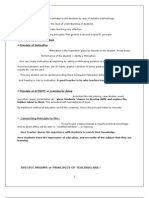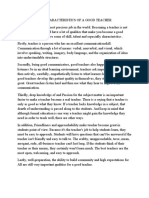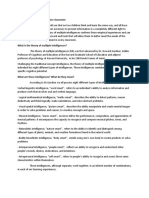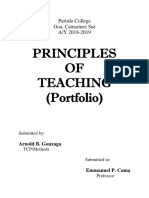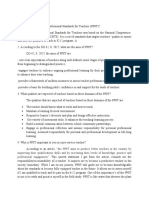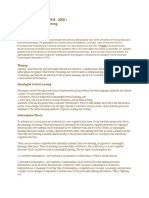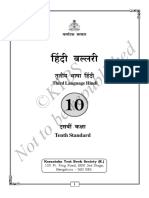Flexible Learning
Flexible Learning
Uploaded by
Kuunal Anil IndurkarCopyright:
Available Formats
Flexible Learning
Flexible Learning
Uploaded by
Kuunal Anil IndurkarOriginal Description:
Copyright
Available Formats
Share this document
Did you find this document useful?
Is this content inappropriate?
Copyright:
Available Formats
Flexible Learning
Flexible Learning
Uploaded by
Kuunal Anil IndurkarCopyright:
Available Formats
DISTANCE EDUCATION - FLEXIBLE LEARNING
Dr. Renu Bayaskar
Asstt. Professor,
Post Graduate Deptt. of Education
RTM Nagpur University, Nagpur
The Concept of Flexible Learning :
Distance education has moved, in some jurisdictions, from the political and
educational margins into a position where it is viewed by government and institutions
as a mainstream educational process. Distance learning methods and information
technologies are converging with classroom strategies to create what will be a
substantially, different and exciting educational environment. In so doing, they present
intriguing challenges to deeply embedded norms and values, to organizational systems
and structures and to university cultures. In Australia, this convergence is termed
'Flexible learning' while rhetoric still outstrips reality, some universities are
revolutionizing their approaches to how, where, when and what they teach. For them,
'flexible learning' is mainstream educational strategy, not marginal experiment.
A flexible learning environment is one that is assumed to produce quality
outcomes and to be efficient and effective. It is student centred and recognizes
diversity and the importance of equity in access and learning outcomes. As Nunan
(1996) argues, 'put bluntly, flexible learning is code for deep learning. Flexible
learning relied partly on a rich array of resource based learning techniques and
information technologies to respond flexible to the diverse back-ground that students
bring to their study, and to free up the place, time, pace, media and modes of study.
Flexible learning is equally concerned with enabling students to learn how to continue
learning after this study period is finished that is, with the skills and aptitudes of
lifelong learning. The role of the teacher moves from an emphasis on provision of
information and direction of teaching, to facilitator of learning and advisor on
information sources with all that implies for changes in the power relationship
between teacher and learner.
The university of South Australia - in taking a whole institution approach to
flexible learning. In particular, it examines some of the key policy and structural
issued that the university has faced in 1990. Thus for, one could argues that above
values and approaches epitomize any high quality distance education operation. The
key difference for uniSA is that the university intends that the philosophy and
practices of flexible learning will encompass and integrate all its educational
experiences, there by doing organizational and other distinctions between distance and
face-to-face teaching in favour of a spectrum of modes and media appropriate to the
circumstances. The university is building on its history as a dual mode institution with
a well-established distance-education infrastructure to take the this whole of
institution approach to changing teaching and learning, flexible, student centred
learning is not being treated simply as the use of distance education techniques and
information technologies to improve classroom teaching.
This whole institution approach involves a lockstep development of policy and
practice in multiple dimensions of flexible learning. Our distance education institutes
also apply this policy and practice.
As emphasis on equity and openness in access arrangements.
Interaction between and among teacher and learners are as adoptable as
possible in terms of place, time and medium.
Study patterns are diverse and adopted to the requirements of lifelong learners.
Curriculum content is flexible and inclusive.
Teaching and learner support systems accommodate diverse student needs and
learning styles.
Learning resources support the teaching/learning process at every stage.
Appropriate information technologies underpin inquiry and discourse.
Organizational structures and policy process are designed to maximize
flexibility and creativity.
Collaboration with others to improve the quality, range and relevance of
teaching/learning.
The change process of course, has not been smooth or uncontested, and there is
a long way to go before the university can confidently assert that flexible learning
values and practices are ubiquitous. The university has put in place an elaborated
planning and review cycle and quality assurance processes for teaching and learning
that provide a clear corporate view of the nature and speed of change. It has also
created the Flexible Learning Centre (FLC) to provide the specialist services to
support these changes and also take a leading change agent role.
Implications for Flexible Learning :
A whole institution approach to flexible learning is not easily achieved. The
gaps between rhetoric and reality are real as staff come to grips with what teaching
and learning mean in a constantly changing social, political and economic
environment. Flexible learning challenges fundamental values and systems of both
individuals and institutions. The difficulties are compounded by a large gap beween
goals and recourses.
The first challenge is to replace a view that education is either face-to-face on
campus or at a distance, with a blended approach. This is neither easy, nor
uncontested, since distance education is still disparaged by many as a second rate form
of education. There is a need for production facilities and technology, plus a range of
expert supports and process that not only change the time and place of course design
and delivery, but also the number of participants in the processes of teaching and
learning.
Secondly, flexible learning requires a shift ferom a concept of education as
teacher dominated to a learner - centred, constructivist approach based on the
assumption that knowledge can not be taught but only learned or constructed.
Thirdly, the resources required for flexible learning can be a major barrior for
those institutions without pre-existing distance education infrastructures, specialized
professional and technical expertise and appropriate resource allocation mechanisms.
The solution is to collaborate with a distance teaching university or to out source the
necessary expertise and facilities. The FLC for example provides staff development,
materials production and delivery services on contract to several other educational
institutions.
The temptation to reinstate time worn teaching/ learning strategies, renew
emphasis on homogeneity in the student population and concentrate on local rather
than global concerns is barely resistible in the face of the difficulties of innovation and
change. Yet unless we grapple with all the dimensions of flexible learning outlined
here, our institutions will die. They will become irrelevant anachronistic and
regurgitatative, rather than the creative, vibrant and intellectually challenging centres
of the information society that universities should be.
References :
1)
Charles Durran A. (1972) Counselling Learning a Whole - Person Model for
Education, New York and London, Grane and Stration.
2)
Goel Aruna and Goel S. L. (2000) Distance Education in the 21 st century, New
Delhi, Deep and Deep Publication Pvt. Ltd.
3)
Patanjali Prem Chand (2005) Development of Distance Education in India,
New Delhi, Shree Publishers and Distributors.
4)
Sharma Shaloo (2002) Modern Methods of Lifelong Learning and Distance
Education, New Delhi, Sarup and Sons.
You might also like
- Benefits and Barriers of Inclusive EducationDocument23 pagesBenefits and Barriers of Inclusive EducationAmparo ZapantaNo ratings yet
- There Are Two Types of Teaching PrinciplesDocument4 pagesThere Are Two Types of Teaching PrinciplesAditya Jagtap33% (3)
- Shared Reading Lesson and ReflectionDocument2 pagesShared Reading Lesson and Reflectionapi-450232271No ratings yet
- The Teaching Profession Chapter IDocument39 pagesThe Teaching Profession Chapter IPrincess Melanie MelendezNo ratings yet
- Modular Distance Learning Modality in Relation To Students' Learning During Covid-19Document3 pagesModular Distance Learning Modality in Relation To Students' Learning During Covid-19Angeline CaraleNo ratings yet
- 5 Professional Ethics For Teachers - 1Document7 pages5 Professional Ethics For Teachers - 1reymondNo ratings yet
- Use of The Physical Classroom Environment As A Teaching and LearnDocument366 pagesUse of The Physical Classroom Environment As A Teaching and LearnMohd Kharul AnuarNo ratings yet
- The Demands of Society From The Teacher As A ProfessionalDocument7 pagesThe Demands of Society From The Teacher As A ProfessionallorenzoNo ratings yet
- Science 3-10 CGDocument66 pagesScience 3-10 CGGerundio Agustin JrNo ratings yet
- Assignment - Philosophy in LifeDocument8 pagesAssignment - Philosophy in LifeArjay PascuaNo ratings yet
- Lesson 2Document3 pagesLesson 2Adrienne MojicaNo ratings yet
- Educ 1 Exam 1st-2ndDocument3 pagesEduc 1 Exam 1st-2ndJADE RAMESH LUAREZNo ratings yet
- Ariane Rose Angelie P. Tolosa Educ 219 Dipt-4-SDocument3 pagesAriane Rose Angelie P. Tolosa Educ 219 Dipt-4-Sjoan sabranNo ratings yet
- The Characteristics of A Good TeacherDocument2 pagesThe Characteristics of A Good TeacherQuyên Lê TúNo ratings yet
- Sara Solano What Makes A Good Teacher GreatDocument3 pagesSara Solano What Makes A Good Teacher Greatapi-535189791No ratings yet
- Importance of Educational TechnologyDocument4 pagesImportance of Educational Technologywichupinuno100% (2)
- Final EssayDocument9 pagesFinal EssayTania HerediaNo ratings yet
- TeaProfActivity Topic6and7Document4 pagesTeaProfActivity Topic6and7Abegail arcigaNo ratings yet
- Ed 52 - Multi-Grade Teaching The MentorsDocument5 pagesEd 52 - Multi-Grade Teaching The Mentorsapi-550734106No ratings yet
- Math CurriculumDocument26 pagesMath CurriculumJohnCarloLabayNo ratings yet
- BrunerDocument13 pagesBrunerLauraNo ratings yet
- Sample Educational Philosophy StatementsDocument2 pagesSample Educational Philosophy StatementsAirene Abear PascualNo ratings yet
- My Philosophy of EducationDocument1 pageMy Philosophy of EducationMa'am FhatzNo ratings yet
- BF Skinner Operant Conditioning (B)Document15 pagesBF Skinner Operant Conditioning (B)Elaiza HerreraNo ratings yet
- The Aims of The Enhanced K12 orDocument9 pagesThe Aims of The Enhanced K12 orNoly TicsayNo ratings yet
- Ca15 Activity 1 (Chapter 2)Document2 pagesCa15 Activity 1 (Chapter 2)Mark Kenneth CeballosNo ratings yet
- The Teacher As A ProfessionalDocument18 pagesThe Teacher As A ProfessionalNajmul HasanNo ratings yet
- Strand 1.1 Teacher's Actions Demonstrative Value For LearningDocument4 pagesStrand 1.1 Teacher's Actions Demonstrative Value For LearningJoan Tariao Uy100% (1)
- Module in TPDocument9 pagesModule in TPQuenie De la CruzNo ratings yet
- Ed TechDocument6 pagesEd TechakylNo ratings yet
- BUILDINGDocument8 pagesBUILDINGDojonel ValdezNo ratings yet
- PPSTDocument4 pagesPPSTdrewNo ratings yet
- ANGELIC - Salient Features of K To 12 - SPTOPDocument16 pagesANGELIC - Salient Features of K To 12 - SPTOPAngelic AlmaydaNo ratings yet
- Policies and Issues On Internet and Implications To Teaching and LearningDocument2 pagesPolicies and Issues On Internet and Implications To Teaching and LearningCENABRE, CHERLE N.BEEDNo ratings yet
- EDUC 2 (Activity 5)Document4 pagesEDUC 2 (Activity 5)Omar Gragasin ArenasNo ratings yet
- Teaching in Multiple Intelligence ClassroomDocument2 pagesTeaching in Multiple Intelligence ClassroomBaby Panda100% (2)
- Lesson 1Document12 pagesLesson 1James MacaspacNo ratings yet
- EDU 102, School Culture Community (PRELIMS COVERAGE)Document44 pagesEDU 102, School Culture Community (PRELIMS COVERAGE)Cadim'z KyelloiedNo ratings yet
- Orca Share Media1620985703340 6798906819466053295Document38 pagesOrca Share Media1620985703340 6798906819466053295Apple Allyssah Comabig SegalesNo ratings yet
- How Physical Exercise Help and Its BenefitsDocument1 pageHow Physical Exercise Help and Its BenefitsAudrey AnnNo ratings yet
- Mother Tongue-Based Learning Makes Lessonsmore Interactive and Easier For StudentsDocument4 pagesMother Tongue-Based Learning Makes Lessonsmore Interactive and Easier For StudentsAngelica Faye LitonjuaNo ratings yet
- School Experience Reflection Journal Generaled 250Document6 pagesSchool Experience Reflection Journal Generaled 250api-284809101No ratings yet
- Portpolio Sir CamaDocument40 pagesPortpolio Sir CamaCindy BacsainNo ratings yet
- Module 6 Teaching Multigrade ClassesDocument2 pagesModule 6 Teaching Multigrade ClassesWinter BacalsoNo ratings yet
- The Challenges of Modular Distance LearningDocument2 pagesThe Challenges of Modular Distance LearningMark Jerico MoralesNo ratings yet
- Broadening Teaching PerspectivesDocument2 pagesBroadening Teaching PerspectivesMaureen Mae EstanolNo ratings yet
- The 21st Century TeacherDocument6 pagesThe 21st Century TeacherAngilly LibreaNo ratings yet
- Crizaldo Module 4 PPSTDocument2 pagesCrizaldo Module 4 PPSTJhon AgustinNo ratings yet
- Unit 4 in Prof - Ed.7 PDFDocument10 pagesUnit 4 in Prof - Ed.7 PDFcjudebetanzorNo ratings yet
- BLAYA, PJ - Module 5 - Lesson 6Document2 pagesBLAYA, PJ - Module 5 - Lesson 6Phranxies Jean Blaya100% (1)
- What Is A Performance TaskDocument38 pagesWhat Is A Performance TaskMiziana Suhana Binti Saboo IPGKPINo ratings yet
- Characteristic of Good Curriculum PDFDocument11 pagesCharacteristic of Good Curriculum PDFMarianel Antiqueña EspinosaNo ratings yet
- Intended Learning Outcome:: Lesson 10: Media LiteracyDocument4 pagesIntended Learning Outcome:: Lesson 10: Media LiteracyAnn AguantaNo ratings yet
- 21st Century LearningDocument12 pages21st Century LearningAulia RizkiNo ratings yet
- EDUC 205 LESSON No. 1 (LM # 4 Final)Document8 pagesEDUC 205 LESSON No. 1 (LM # 4 Final)Ellarence RafaelNo ratings yet
- FS 1 PORTFOLIO Episode 1 ENCINA, JULIE JEAN BEED 4B-DAYDocument8 pagesFS 1 PORTFOLIO Episode 1 ENCINA, JULIE JEAN BEED 4B-DAYJulie Jean Restauro EncinaNo ratings yet
- 2019 Code of Ethics For Professional Teachers Explained - DEPED TAMBAYANDocument17 pages2019 Code of Ethics For Professional Teachers Explained - DEPED TAMBAYANHeart Wp100% (1)
- 21st Century Skills Module - 2.lesson-1Document2 pages21st Century Skills Module - 2.lesson-1Nova Myrel RECIMONo ratings yet
- PED05 - Lesson 13 - Cooperative and Experiential LearningDocument2 pagesPED05 - Lesson 13 - Cooperative and Experiential LearningLaurence Alemania Dacillo100% (1)
- David Ausubel (Verbal Learning Theory)Document2 pagesDavid Ausubel (Verbal Learning Theory)Gie Marie Francisco Umali100% (1)
- Enhancing Competency of Teachers: A Teaching-And-Learning Enhancement GuideFrom EverandEnhancing Competency of Teachers: A Teaching-And-Learning Enhancement GuideNo ratings yet
- 1 28 14 Zinc Chloride Lab ReportDocument3 pages1 28 14 Zinc Chloride Lab Reportapi-247378686No ratings yet
- COT Rating ConsolidationDocument1 pageCOT Rating ConsolidationCatherine Sophia CorpuzNo ratings yet
- Six Models of Lesson Observation: An International PerspectiveDocument24 pagesSix Models of Lesson Observation: An International PerspectiveBenedictNo ratings yet
- Minutes Focus Group Discussion (FGD) On Ways To Help Failing StudentsDocument4 pagesMinutes Focus Group Discussion (FGD) On Ways To Help Failing StudentsJanelle Cui100% (3)
- Lesson Plan ListeningDocument3 pagesLesson Plan ListeningRena JulianaNo ratings yet
- SAMPLE 7es LPDocument2 pagesSAMPLE 7es LPJhester BaylosisNo ratings yet
- Movement Dance Lesson PlanDocument2 pagesMovement Dance Lesson Planapi-660829902No ratings yet
- Authentic Assessment in Efl Teaching and Learning: Volume 9, No. 1, February 2018Document10 pagesAuthentic Assessment in Efl Teaching and Learning: Volume 9, No. 1, February 2018dbbony 0088No ratings yet
- Intasc StandardsDocument4 pagesIntasc Standardsapi-486184360No ratings yet
- Silbaugh-Personal Practical TheoryDocument6 pagesSilbaugh-Personal Practical Theoryapi-249359495No ratings yet
- Status of Teaching Geography in The Secondary Schools of Kerala and The Associated Major HurdlesDocument5 pagesStatus of Teaching Geography in The Secondary Schools of Kerala and The Associated Major HurdlesSarita TirkeyNo ratings yet
- Participate and AssistDocument4 pagesParticipate and AssistLovely Rose MorenoNo ratings yet
- Telling Time Lesson PlanDocument5 pagesTelling Time Lesson Planapi-373383732No ratings yet
- Oral Defense RubricDocument2 pagesOral Defense Rubricjomar lipaopaoNo ratings yet
- Resume 2022Document4 pagesResume 2022api-625331248No ratings yet
- Teacher CompetenciesDocument1 pageTeacher CompetenciesRosabelleMikeNo ratings yet
- EAPP Week6Document3 pagesEAPP Week6Hannae pascua100% (1)
- I-Day 4Document6 pagesI-Day 4CRISTILE ANN GESMANNo ratings yet
- Reaganomics Debate Prep Lesson PlanDocument3 pagesReaganomics Debate Prep Lesson Planapi-315333838No ratings yet
- KAREN CHOI Comprehensive CVDocument5 pagesKAREN CHOI Comprehensive CVKarenChoiNo ratings yet
- 10th Language Hindi 3Document220 pages10th Language Hindi 3GURRURAJ DHANKSSNo ratings yet
- ITEM ANALYSIS FOR 2015-2016: SUBJECT: - Grade-TeacherDocument1 pageITEM ANALYSIS FOR 2015-2016: SUBJECT: - Grade-TeacherCristina Niñalga SumalbagNo ratings yet
- Jasmin Hooker ResumeDocument1 pageJasmin Hooker Resumeapi-207121547No ratings yet
- 5e Lesson Plan ProbesDocument3 pages5e Lesson Plan Probesapi-220472700No ratings yet
- Episode 12. Activity 12.1 ArtifactsDocument2 pagesEpisode 12. Activity 12.1 ArtifactsShardy C. AGUTONo ratings yet
- 1 EvidenceRequirementDocument2 pages1 EvidenceRequirementjenesis dimayugaNo ratings yet
- CivicsDocument1 pageCivicsNorizah Baba100% (1)
- Detailed Lesson Plan (DLP)Document3 pagesDetailed Lesson Plan (DLP)Valdeleon Taguiam CatherineNo ratings yet
- Parent Teacher ConferencesDocument3 pagesParent Teacher Conferencesapi-534720450No ratings yet

